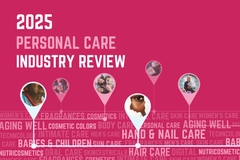From production to packaging: How the personal care industry is contributing to a circular economy

Companies are considering a circular supply chain at all stages of personal care product production, from formulation to packaging, with a goal of reducing waste and prolonging material use before it reaches a landfill. Customer preference for goods that reduce overall waste is driving this move.
According to The Upcycled Beauty Company’s Zero Waste Beauty Report 2025, packaging accounts for 70% of the beauty industry’s waste and 95% of cosmetic packaging is thrown away. This results in the destruction of US$4.8 billion worth of beauty products annually.
Personal Care Insights speaks to Lignopure and TNT Group about how they are contributing to a circular economy in the beauty sector for product ingredients and packaging.
Gabriela Meza Armenta, head of sales and marketing at Lignopure, highlights that technologies are allowing the development of byproducts and waste streams that increase the portfolio of upcycled cosmetic ingredients.
“[These technologies] allow manufacturers to develop the next generation of sustainable products. The transition to circular and upcycled materials and ingredients is essential for the cosmetics industry to minimize its environmental impact, enhance its economic viability and fulfill its social responsibility,” she says.
“In the not-too-distant future, consumers will seek ‘% upcycled origin’ as they seek ‘vegan’ in cosmetic packaging.”
Traceability trend
The packaging sector contributes largely to circularity in personal care. TNT Group names quiet luxury a driving trend in beauty packaging, demanding monomaterial and simpler components.
“[These solutions] are much easier to recycle but are more expensive. The real challenge is the mass or masstige products which try to look nice but cannot be recycled. I think in particular of metalized or plated plastics which cannot be recycled,” Thomas Diezinger, chairman and CEO at TNT Group, tells us.
Armenta predicts that cosmetics will be more readily available in biodegradable and compostable packaging and names traceability as another rising trend for beauty circularity.
 Gabriela Meza Armenta, head of sales and marketing manager at Lignopure.“I think traceability will continue to grow, and brands will start to give more information to consumers and look closer at where they source their raw materials.”
Gabriela Meza Armenta, head of sales and marketing manager at Lignopure.“I think traceability will continue to grow, and brands will start to give more information to consumers and look closer at where they source their raw materials.”
Industry innovations
Lignopure says it contributes to a circular economy by utilizing lignin, a byproduct of the pulp and paper industry, for cosmetic ingredients under the LignoBase brand.
Using LignoBase, cosmetic manufacturers can address waste reduction and resource efficiency as the cosmetic ingredient is biodegradable, multifunctional and non-toxic.
TNT Group says it is striving to produce primary and secondary packaging from a single recyclable material and highlights its use of metals such as aluminum and zamak, an alloy with a base of zinc.
“The aluminum recycling chain is fully operational, and the zamak recycling chain also exists under our impulsion at the industrial level. Recycled aluminum and zamak require far less energy to produce components than virgin/new materials,” says Diezinger.
“These are perfect examples of materials that fit into the circular economy, and we are proud to be part of this change of mind. By the end of 2025, around 30% of our total production will be done using recycled zamak.”
Circular challenges
Diezinger explains that creating pieces that look and feel luxurious is a challenge when making circular packaging solutions for the beauty industry but calls attention to aluminum and zamak as solutions. In 2024, TNT Group’s refillable designs using these materials for Westman and Chanel received FDL awards.
“The real challenge is more for our customers, i.e., brands: How can we deal with the greater complexity of logistics for refills? How can we educate end consumers to use refillable products? What incentive can they get to embrace this new habit?”
Regarding the circularity of cosmetic ingredients, Lignopure says that working with lignin has presented several challenges.
“One is the inherent complexity of lignin that varies depending on its source, w TNT Group designs packaging for beauty brands such as Westman Atelier.hich we at Lignopure have addressed by carefully selecting lignin sources and from specific extraction processes to ensure batch-to-batch consistency and the best cosmetic performance for our clients,” says Armenta.
TNT Group designs packaging for beauty brands such as Westman Atelier.hich we at Lignopure have addressed by carefully selecting lignin sources and from specific extraction processes to ensure batch-to-batch consistency and the best cosmetic performance for our clients,” says Armenta.
“Another challenge was that lignin is generally insoluble in many common cosmetic solvents. Therefore, we developed a proprietary technology that transforms and optimizes raw lignin into micronized non-nano particles with optimized shape, improving its dispersibility and compatibility with various cosmetic formulations.”
Government action
The Upcycled Beauty Company report finds that 14% of cosmetic packaging makes it to recycling plants, but only 9% is recycled. Companies are asking for improved government clarification and implementation to streamline and increase circularity in the beauty industry.
Lignopure says clear definitions of circularity, upcycling and related terms are needed to prevent greenwashing and ensure consistent regulation application to policies that incentivize the use of recycled and upcycled materials. It also calls for better end-of-life management of cosmetic products and packaging.
“A greater harmonization of regulations across different regions would facilitate the adoption of circular practices on a global scale,” asserts Armenta.
“Governments have a crucial role in driving the transition to a circular economy in the beauty industry and any industry. Legislation can provide a level playing field for businesses, encourage innovation, and ensure environmental goals are met.”
Armenta calls voluntary initiatives valuable but questions if they are sufficient to achieve “necessary systemic changes,” saying that well-designed regulations create clear targets for the industry and ensure accountability.
Diezinger adds that governments should and do implement legislation to make the beauty industry more circular.
“Their help is crucial in supporting SMEs along this path, as complying with all the regulations requires a lot of resources,” says Diezinger.
“The complexity lies in harmonizing practices worldwide, not just for the cosmetics industry. Recycling channels are not at the same level of maturity. We also need to do a great deal of consumer education. Brands have a major influence on consumers and suppliers by demanding traceability throughout the value chain. And once again, at a global level, it’s a challenge.”












